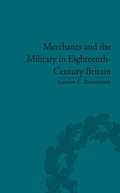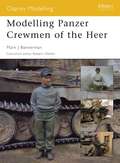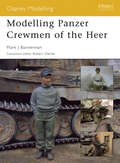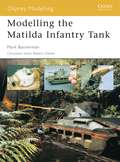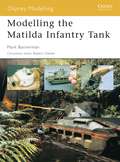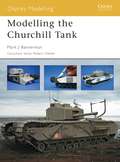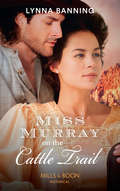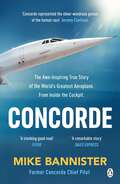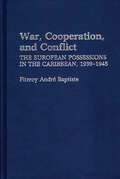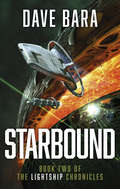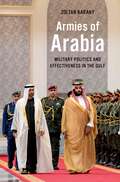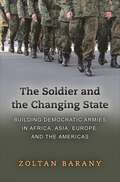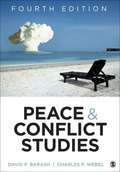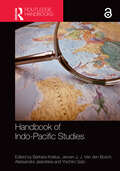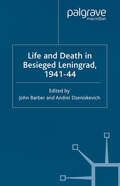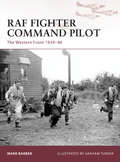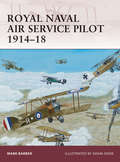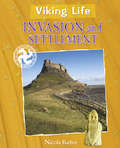- Table View
- List View
Merchants and the Military in Eighteenth-Century Britain: British Army Contracts and Domestic Supply, 1739-1763
by Gordon E. BannermanInvestigates the contract sector of the British Army during the long eighteenth century. This book argues that this group of financiers, private merchants, businessmen and farmers represented a vital interest group which was at the nexus of the fiscal-military structure. It draws on papers from the War Office, the Treasury and the Audit Office.
Merchants and the Military in Eighteenth-Century Britain: British Army Contracts and Domestic Supply, 1739-1763
by Gordon E. BannermanInvestigates the contract sector of the British Army during the long eighteenth century. This book argues that this group of financiers, private merchants, businessmen and farmers represented a vital interest group which was at the nexus of the fiscal-military structure. It draws on papers from the War Office, the Treasury and the Audit Office.
Modelling Panzer Crewmen of the Heer (Osprey Modelling)
by Mark BannermanA wonderfully detailed and beautifully finished armour model can easily be let down if accompanied by a poorly painted figure. The addition of scale figures helps provide depth, weight and realism to a model yet working with figures continues to be most armour modellers' worst nightmare. This book provides tips and techniques for building, converting and painting World War II German Army Panzer crew figures, in clear step-by-step instructions. Among the topics covered are how to paint different uniforms using enamels and oils; converting and scratch-building figures; painting heads and flesh tones; and weathering clothing.
Modelling Panzer Crewmen of the Heer (Osprey Modelling)
by Mark BannermanA wonderfully detailed and beautifully finished armour model can easily be let down if accompanied by a poorly painted figure. The addition of scale figures helps provide depth, weight and realism to a model yet working with figures continues to be most armour modellers' worst nightmare. This book provides tips and techniques for building, converting and painting World War II German Army Panzer crew figures, in clear step-by-step instructions. Among the topics covered are how to paint different uniforms using enamels and oils; converting and scratch-building figures; painting heads and flesh tones; and weathering clothing.
Modelling the Matilda Infantry Tank (Osprey Modelling)
by Mark BannermanThe Matilda tank saw action in almost all theatres of World War II, from Europe to the Pacific. Born in the interwar years, and developed with numerous modifications following combat testing, the Matilda is perhaps most famous for its role in the desert campaigns of 1940-41, thus acquiring its nickname 'Queen of the Desert'. This book provides a detailed guide to modelling the Matilda tank across a variety of types, colour schemes and scales, and features excellent reference photos. Using clearly explained techniques and methods, and featuring the work of several top modellers, this step-by-step guide to building, finishing and displaying the Matilda in European, Western Desert and Australian service presents a creative and enagaging approach to modelling the 'Tilly'.
Modelling the Matilda Infantry Tank (Osprey Modelling #5)
by Mark BannermanThe Matilda tank saw action in almost all theatres of World War II, from Europe to the Pacific. Born in the interwar years, and developed with numerous modifications following combat testing, the Matilda is perhaps most famous for its role in the desert campaigns of 1940-41, thus acquiring its nickname 'Queen of the Desert'. This book provides a detailed guide to modelling the Matilda tank across a variety of types, colour schemes and scales, and features excellent reference photos. Using clearly explained techniques and methods, and featuring the work of several top modellers, this step-by-step guide to building, finishing and displaying the Matilda in European, Western Desert and Australian service presents a creative and enagaging approach to modelling the 'Tilly'.
Modelling the Churchill Tank (Osprey Modelling)
by Mark Bannerman Dinesh NedThe Churchill saw much action in World War II, from the 1942 raid on Dieppe, through the heat of the battles in North Africa, to the bitter fighting in Normandy 1944 and into the Reich in 1945. Despite criticism that it was slow and outmoded in terms of design, it proved itself a rugged and solid vehicle.This title provides a comprehensive guide to modelling the Churchill across a range of skill levels, featuring challenging builds of numerous marks and variants, including brideglayers, flame-throwers (such as the Crocodile) and customised assault vehicles (such as the spigot-mortar armed ARVE).
Modelling the Churchill Tank (Osprey Modelling)
by Mark Bannerman Dinesh NedThe Churchill saw much action in World War II, from the 1942 raid on Dieppe, through the heat of the battles in North Africa, to the bitter fighting in Normandy 1944 and into the Reich in 1945. Despite criticism that it was slow and outmoded in terms of design, it proved itself a rugged and solid vehicle.This title provides a comprehensive guide to modelling the Churchill across a range of skill levels, featuring challenging builds of numerous marks and variants, including brideglayers, flame-throwers (such as the Crocodile) and customised assault vehicles (such as the spigot-mortar armed ARVE).
Miss Murray On The Cattle Trail: Miss Murray On The Cattle Trail The Warrior's Viking Bride The Ton's Most Notorious Rake (Mills And Boon Historical Ser.)
by Lynna BanningA cattle drive is no place for a greenhorn… …but this city miss is here for the ride!
Concorde: The thrilling account of history’s most extraordinary airliner
by Mike BannisterThe definitive account of the rise and fall of the iconic Concorde plane from British Airways' former Chief Concorde Pilot'A remarkable story' DAILY EXPRESS'A stonking good read' FLYER_________What's it like to fly faster than a bullet?Could you really glimpse the edge of space?Why will we never see Concorde's like again?Mike Bannister was British Airways' Chief Concorde Pilot. One of the few in that legendary aircraft's quarter-century of flight to fully understand both the plane's intricate engineering and what it took to fly her at supersonic speeds.In this definitive account of the rise and fall of the world's greatest aircraft, Bannister explores its origins, development, service, highs, lows and, finally, the terrible crash which ended its flying life.Part celebration, part history, part detective story and part courtroom drama, it's almost as riveting as flying in Concorde itself - almost . . ._________'Concorde represented the sheer wondrous genius of the human race' JEREMY CLARKSON
War, Cooperation, and Conflict: The European Possessions in the Caribbean, 1939-1945 (Contributions in Comparative Colonial Studies)
by Fitzroy BaptisteThis carefully researched study is the first to chronicle the history of Allied involvement in the defense of British, French, and Dutch possessions in the Caribbean. The study is extremely well researched and well written. . . . The definitive work in this particular area of historical research, based on all available sources in English, French, and Dutch, published and unpublished. ChoiceAlthough few military campaigns were fought in the Caribbean, the region had strategic importance throughout World War II for the United States and its allies. This carefully researched study is the first to chronicle the history of Allied involvement in the defense of British, French, and Dutch possessions in the Caribbean. The first chapter examines the events and diplomacy that led in 1939 to Britain's granting the United States permission to base military facilities in Bermuda, St. Lucia, and Trinidad and to the creation of the Caribbean Sea Frontier. Later chapters detail the troubled course of British-American cooperation as U.S. military commitments--and regional dominance--increased. Also described is the role of the Netherlands, with Britain and the United States, in the defense of the oil and bauxite reserves in the Dutch Caribbean territories, and the friction between Britain and the United States over French Caribbean possessions. The final chapters analyze strategic shifts occuring as a result of the war and influencing postwar settlements negotiated for the region.
Starbound: Volume Two Of The Lightship Chronicles (Lightship Chronicles Ser.)
by Dave BaraTHE FIRST EMPIRE HAS RETURNED.THE NEW GALACTIC UNION HANGS IN THE BALANCE…The Lightship Impulse is gone, sacrificed while defeating First Empire ships the fragile new galactic alliance hoped it would never see again. For Peter Cochrane, serving as third officer on the Starbound and tasked with investigating a mysterious space station in a newly re-discovered system, the wounds of battle may have healed, but the war is far from over...
Starbound: Volume Two Of The Lightship Chronicles (Lightship Chronicles Ser. #2)
by Dave BaraTHE FIRST EMPIRE HAS RETURNED.THE NEW GALACTIC UNION HANGS IN THE BALANCE…The Lightship Impulse is gone, sacrificed while defeating First Empire ships the fragile new galactic alliance hoped it would never see again. For Peter Cochrane, serving as third officer on the Starbound and tasked with investigating a mysterious space station in a newly re-discovered system, the wounds of battle may have healed, but the war is far from over...
World War II Historical Reenactment in Poland: The Practice of Authenticity (Routledge Studies in Second World War History)
by Kamila Baraniecka-OlszewskaThis book explores the consequences of the latest political shifts in Central Eastern Europe: the rise of right-wing parties and, among other things, politics becoming more invested in history. These phenomena coincide and overlap with the democratisation of history by turning the past into a hot topic, persistently present in the public sphere and often evoking strong emotions. Ethnographic research (conducted in 2012-2016) focusing on how World War II reenactors experience the past serves as the basis to analyse the ways in which the group uses the widespread, often institutionalised interest in history to – on the one hand – become involved in debates on World War II and the remembrance thereof, and – on the other – to authentically experience this past. The volume therefore analyses how physical the process of creating and experiencing grassroots visions of the past is, and how these visions interact with the public discourse about the past. Reenactors’ ability to marry the often-contradictory orders of historical truth, authenticity, and representation is explored. Moreover, Baraniecka-Olszewska analyses how the reenactors overcome various obstacles on their way towards authentic experiences, performing history through their bodies.
World War II Historical Reenactment in Poland: The Practice of Authenticity (Routledge Studies in Second World War History)
by Kamila Baraniecka-OlszewskaThis book explores the consequences of the latest political shifts in Central Eastern Europe: the rise of right-wing parties and, among other things, politics becoming more invested in history. These phenomena coincide and overlap with the democratisation of history by turning the past into a hot topic, persistently present in the public sphere and often evoking strong emotions. Ethnographic research (conducted in 2012-2016) focusing on how World War II reenactors experience the past serves as the basis to analyse the ways in which the group uses the widespread, often institutionalised interest in history to – on the one hand – become involved in debates on World War II and the remembrance thereof, and – on the other – to authentically experience this past. The volume therefore analyses how physical the process of creating and experiencing grassroots visions of the past is, and how these visions interact with the public discourse about the past. Reenactors’ ability to marry the often-contradictory orders of historical truth, authenticity, and representation is explored. Moreover, Baraniecka-Olszewska analyses how the reenactors overcome various obstacles on their way towards authentic experiences, performing history through their bodies.
Armies of Arabia: Military Politics and Effectiveness in the Gulf
by Zoltan BaranyArmies of Arabia is the first comprehensive analysis of the Gulf monarchies' armed forces, including their political, social, and economic characteristics, foreign relations, and battleground performance. The Arabian Peninsula is among the most strategically and economically important areas in the world, but its militaries remain terra incognita. In Armies of Arabia - the first book to comprehensively analyze the Gulf monarchies' armed forces - Zoltan Barany explains their notorious ineffectiveness with a combination of political-structural and sociocultural factors. Drawing on over 150 interviews and meticulous multidisciplinary research, Barany paints a fascinating portrait of Arabia's armies from Ibn Saud's Ikhwan to the present. He explores the methods ruling families employ to ensure their armies' loyalty, examines the backgrounds and career trajectories of soldiers and officers, and explains the monarchies' reliance on mercenaries and the enduring importance of tribal networks. Even though no other world region spends more on security, Arabia's armies remain ineffective because of an absence of meritocracy, the domination of personal connections over institutional norms, insipid leadership, a casual work ethic, and training that lacks intensity, frequency, and up-to-date scenarios. Massive weapons acquisitions are primarily pay-offs to the US for protecting them and have resulted in bloated and inappropriate arsenals and large-scale corruption. Barany explains why the Gulf Cooperation Council has been a squandered opportunity and examines the kingdoms' military relationships with the Arab world and beyond. The performance of the Saudi-led coalition's disastrous war in Yemen starkly illustrates the Gulf armies' humiliating combat record. The book concludes with thoughts on waste (of human potential, resources, institutions) as a dominant theme of Gulf military affairs, considers likely changes in response to long-term weakening demand for oil, and suggests ways in which the armies' effectiveness could be raised. Chock-full of insights and stories from the field and written with a general audience in mind, Armies of Arabia will be essential reading for anyone interested in military affairs and Middle Eastern politics, society, and international relations.
Armies of Arabia: Military Politics and Effectiveness in the Gulf
by Zoltan BaranyArmies of Arabia is the first comprehensive analysis of the Gulf monarchies' armed forces, including their political, social, and economic characteristics, foreign relations, and battleground performance. The Arabian Peninsula is among the most strategically and economically important areas in the world, but its militaries remain terra incognita. In Armies of Arabia - the first book to comprehensively analyze the Gulf monarchies' armed forces - Zoltan Barany explains their notorious ineffectiveness with a combination of political-structural and sociocultural factors. Drawing on over 150 interviews and meticulous multidisciplinary research, Barany paints a fascinating portrait of Arabia's armies from Ibn Saud's Ikhwan to the present. He explores the methods ruling families employ to ensure their armies' loyalty, examines the backgrounds and career trajectories of soldiers and officers, and explains the monarchies' reliance on mercenaries and the enduring importance of tribal networks. Even though no other world region spends more on security, Arabia's armies remain ineffective because of an absence of meritocracy, the domination of personal connections over institutional norms, insipid leadership, a casual work ethic, and training that lacks intensity, frequency, and up-to-date scenarios. Massive weapons acquisitions are primarily pay-offs to the US for protecting them and have resulted in bloated and inappropriate arsenals and large-scale corruption. Barany explains why the Gulf Cooperation Council has been a squandered opportunity and examines the kingdoms' military relationships with the Arab world and beyond. The performance of the Saudi-led coalition's disastrous war in Yemen starkly illustrates the Gulf armies' humiliating combat record. The book concludes with thoughts on waste (of human potential, resources, institutions) as a dominant theme of Gulf military affairs, considers likely changes in response to long-term weakening demand for oil, and suggests ways in which the armies' effectiveness could be raised. Chock-full of insights and stories from the field and written with a general audience in mind, Armies of Arabia will be essential reading for anyone interested in military affairs and Middle Eastern politics, society, and international relations.
The Soldier and the Changing State: Building Democratic Armies in Africa, Asia, Europe, and the Americas
by Zoltan BaranyThe Soldier and the Changing State is the first book to systematically explore, on a global scale, civil-military relations in democratizing and changing states. Looking at how armies supportive of democracy are built, Zoltan Barany argues that the military is the most important institution that states maintain, for without military elites who support democratic governance, democracy cannot be consolidated. Barany also demonstrates that building democratic armies is the quintessential task of newly democratizing regimes. But how do democratic armies come about? What conditions encourage or impede democratic civil-military relations? And how can the state ensure the allegiance of its soldiers? Barany examines the experiences of developing countries and the armed forces in the context of major political change in six specific settings: in the wake of war and civil war, after military and communist regimes, and following colonialism and unification/apartheid. He evaluates the army-building and democratization experiences of twenty-seven countries and explains which predemocratic settings are most conducive to creating a military that will support democracy. Highlighting important factors and suggesting which reforms can be expected to work and fail in different environments, he offers practical policy recommendations to state-builders and democratizers.
The Soldier and the Changing State: Building Democratic Armies in Africa, Asia, Europe, and the Americas
by Zoltan BaranyThe Soldier and the Changing State is the first book to systematically explore, on a global scale, civil-military relations in democratizing and changing states. Looking at how armies supportive of democracy are built, Zoltan Barany argues that the military is the most important institution that states maintain, for without military elites who support democratic governance, democracy cannot be consolidated. Barany also demonstrates that building democratic armies is the quintessential task of newly democratizing regimes. But how do democratic armies come about? What conditions encourage or impede democratic civil-military relations? And how can the state ensure the allegiance of its soldiers? Barany examines the experiences of developing countries and the armed forces in the context of major political change in six specific settings: in the wake of war and civil war, after military and communist regimes, and following colonialism and unification/apartheid. He evaluates the army-building and democratization experiences of twenty-seven countries and explains which predemocratic settings are most conducive to creating a military that will support democracy. Highlighting important factors and suggesting which reforms can be expected to work and fail in different environments, he offers practical policy recommendations to state-builders and democratizers.
Peace and Conflict Studies (PDF)
by David P. Barash Charles P. WebelPeace and Conflict Studies sets the standard for an accessible introduction and comprehensive exploration of this vital subject. The authors share their vast knowledge and analysis of 21st-century world events - including chapters on research methods and democracy, as well as timely topics such as nuclear proliferation; models of conflict analysis, outcomes, and solutions; the Non-Proliferation Treaty; the rise of the BRICs countries; and much more. The text, authored by David Barash and Charles Webel, examines current conflicts, including the latest developments in Iran and North Korea, explores the important aspects of positive peace, individual violence, nationalism, and terrorism, provides numerous visual aids, questions for further study, and suggested readings, and furnishes a comprehensive range of material to enlighten and enrich future discussion and encourage further academic pursuit. With an broad and authoritative scope, this introductory text chronicles a plethora of important global topics from pre-history to the present.
Handbook of Indo-Pacific Studies (Indo-Pacific in Context)
by Barbara Kratiuk, Jeroen J. J. Van den Bosch, Aleksandra Jaskólska and Yoichiro SatoThis handbook explores the significance of the Indo-Pacific in world politics. It shows how the re-emergence of the Indo-Pacific in international relations has fundamentally changed the approach to politics, economics and security. The volume: explores the themes related to trade, politics and security for better understanding of the Indo-Pacific and the repercussions of the region's emergence studies different security and political issues in the region: military competition, maritime governance, strategic alliances and rivalries, and international conflicts analyses various socio-economic dimensions of the Indo-Pacific, such as political systems, cultural and religious contexts, and trade and financial systems examines the strategies of various states, such as the United States, Japan, India and China, and their approaches towards the Indo-Pacific covers the role of middle powers and small states in detail Interdisciplinary in approach and with essays from authors from around the world, this volume will be indispensable to scholars, researchers and students in the fields of international relations, politics and Asian studies.
Life and Death in Besieged Leningrad, 1941-1944 (Studies in Russian and East European History and Society)
by J. Barber A. DzeniskevichFrom 1941-1944 Leningrad saw by far the largest-scale famine ever to occur in a developed society. This book examines the nature and consequences of the extreme conditions created by the German blockade of Leningrad between September 1941 and January 1944. Using declassified documents from Party and State archives in Moscow and St Petersburg and interviews with survivors, the authors have produced the most informed and detailed analysis to date of the impact of the siege on the lives and health of the people of Leningrad.
RAF Fighter Command Pilot: The Western Front 1939–42 (Warrior #164)
by Mark BarberThe recent 70th anniversary of the Battle of Britain, combined with the threat of significant cuts to the current RAF, have highlighted the importance of Fighter Command in the early days of World War II once more. The role of the “few”, as described by Churchill, during the Battle of Britain has been the subject of much mythologizing both at the time and in the years since. This title will put Fighter Command in context; describing the lack of funding and attention which it received during the interwar period, until it was almost too late. The myth of the fighter pilot will be humanized, with first-hand accounts quoted which put nervous but brave human beings from all walks of life in the cockpit. Although the Battle of Britain may not have in itself been the decisive encounter that it has historically been portrayed as, the moral victory won by the RAF, the victory that proved that Germany could be defeated, was just as important as a military-strategic victory.
Royal Naval Air Service Pilot 1914–18 (Warrior #152)
by Mark Barber Mr Adam HookIn 1914 the Naval Wing of the Royal Flying Corps was subsumed into the Royal Naval Air Service (RNAS). With the bulk of the Royal Flying Corps engaged in France, the aircraft and seaplane pilots of the RNAS protected Britain from the deadly and terrifying Zeppelin menace. In 1915 the RNAS sent aircraft to support the operations in the Dardanelles, and also gave increasing support to the Royal Flying Corps units engaged on the Western Front, conducting reconnaissance, intelligence gathering and artillery spotting, bombing raids, and aerial combat with German pilots. This book explores all of these fascinating areas, and charts the pioneering role of the RNAS in military aviation.
Invasion and Settlement: Invasion And Settlement (Viking Life)
by Nicola BarberThe Viking Life series explores the everyday lives of people who lived during the Viking era. This title looks at Viking invasion and settlement, describing how far Viking travels extended and how the Vikings attacked, fought against or traded with the people they encountered.
